Just cheesecake? Plain cheesecake? No crazy flavours or colours or shapes? That's right. But this is no ordinary cheesecake. My brother asked me to try out this recipe, after having the best cheesecake he's ever had at Trattoria Garga in Florence while on his honeymoon. Lucky for those of us not going to Florence anytime soon, Saveur Magazine printed the recipe for the very same cheesecake. And to jazz it up a little bit, I topped it off with some lemon & poppy seed macarons. Aren't they so sunny and delicious looking? Though a little bit too big for the cake, I may have gotten carried away while piping them...
The cheesecake on its own is relatively simple. The original recipe called for the crust to come up the sides of the pan but I always have trouble making that look pretty, so I only made it for the base. The crust is ridiculously good, a regular biscuit crust, but baked until it is dark golden with a nutty, buttery flavour. The filling is better than any other traditional baked cheesecake I've ever had. I used to find most (non-Japanese) baked cheesecakes were super dense and heavy, with a gluggy sort of texture and way too sweet. I could never eat more than a few bites of it. But this filling has a lovely combination of cream cheese and mascarpone and it is so light and fluffy but not very sweet, giving it a lovely creamy richness without being sickly. It also has this magical top layer made with yoghurt, sugar and vanilla which gives it a delicate contrasting tang and depth of flavour. There's something so elegant about that yoghurt topping, I can't explain it.
The macarons were inspired by some lemon poppyseed macarons that the boy brought back from a Mother's Day high tea at T2. They were severly overbaked and super dry but still had a great lemon zing and I was intrigued to see the poppy seeds were incorporated into the shells. I decided to try them out as they'd been the perfect match for this cheesecake, matching the tangy flavour of the yoghurt coating. I just replaced some of the dry mixture with some poppy seeds and lemon zest and it was great! I loved the extra bite in the shells from the poppy seeds, and a simple lemon butter icing for the filling made them sing. Though I have to admit I had to resist the urge to pipe them in heart shapes.
The best part? No baking in water baths! I hate hate hate baking cheesecakes in water baths, no matter how many layers of clingfilm and foil I wrap around my springform tin, water somehow manages to leak in and make my crust super soggy. Don't be turned off by the length of the recipe below and the number of components, the cheesecake itself is super duper easy - it took me about half an hour prep and 1hr 20 mins total baking time. The macarons were done the night before, but I go into total autopilot mode when I make macarons so they weren't much extra effort for me. If you can't be bothered to do the macarons, just serve up the original cake with some marinated strawberries and it will be just as good. But I do think the macarons make it quite special.
Cheesecake with Lemon Poppyseed Macarons
(Adapted from Sharon's Cheesecake of Trattoria Garga, recipe from Saveur Magazine, serves 8)
For the macarons:
100g aged egg whites (you can use fresh eggs too, just make sure they are room temperature. I always use fresh these days, and zap it in the microwave on defrost for 10 seconds)
105g almond meal, dried in a cool (100 degrees C) oven for 5 minutes and sifted
195g icing sugar
50g sugar
Zest of one lemon, about 1-2 tsp
1 tbsp poppy seeds
Optional: 1 tsp powdered egg whites (available from The Essential Ingredient),
yellow powdered food colouring
50g unsalted butter
2 cups icing sugar, sifted
Juice from half a lemon
For the crust:
2 cups finely crushed digestives (English whole wheat biscuits, can be substituted with graham crackers)
1 tbsp sugar
4 tbsp (approx 60g) unsalted butter, melted
For the cheesecake filling:
1 1/2 cups (approx 390g) cream cheese, softened
1/2 cup plus 2 tbsp (approx 170g) mascarpone
1 cup sugar
3 eggs
For the cheesecake topping:
1 cup plain yogurt
1 tbsp. sugar
1/4 tsp. vanilla extract
(Macarons should be made and refrigerated 24 hours before serving to allow flavour to mature) Line two baking sheets with baking paper. Place icing sugar in food processor and pulse for a minute to remove any lumps. Stir in almond meal and pulse for about 30 seconds to combine. Place in a large mixing bowl and set aside. Using an electric mixer, beat egg whites and egg white powder in a medium mixing bowl until the egg white powder dissolves and it reaches soft peaks. With the mixer on high speed, gradually add sugar (and yellow food colouring if you wish) and beat until it reaches stiff peaks. Add meringue, poppy seeds and lemon zest to your dry mixture and mix, quickly at first to break down the bubbles in the egg white (you really want to deflate/beat all the large bubbles out of the mixture, be rough!), then mix carefully as the dry mixture becomes incorporated and it starts to become shiny again. Take care not to overmix, the mixture should flow like lava and a streak of mixture spread over the surface of the rest of the mixture should disappear after about 30 seconds. Place in a piping bag and pipe rounds of about 3-4cm diameter on baking sheets or silicon baking mats. Gently rap your baking sheets on your bench top to remove any extra bubbles from your piped shells.
Leave this to dry again for at least half an hour, so that when you press the surface of one gently it does not break. This will help prevent any cracking and help the feet to form on the macs. Preheat your oven to 140-150 degrees C. Place on top of an overturned roasting tray or another baking sheet if your sheets are not professional grade, for better heat distribution. Bake for 15-18 minutes, depending on the size of your shells. Remove from the oven and cool on the tray for a few minutes, then gently remove from the sheet and place on a wire rack to cool completely. Remove butter 30 mins before preparing the lemon icing. Beat butter and icing sugar with an electric mixer until pale and fluffy then add lemon juice and beat until smooth. Use a piping bag or spoon to fill your macarons with the icing. Store in the fridge overnight in an airtight container.
For the crust: Preheat oven to 160°C (325°F). Mix crushed biscuits and sugar together in a medium bowl. Add butter and stir until well combined. Transfer crumb mixture to a greased and lined 25cm (10") springform pan (I had to use a 21cm springform pan). Using your hands, spread mixture out in an even layer, then use your fingertips to press crumb mixture into bottom of tin to form an even crust. Transfer to a baking sheet and bake until crust is set and golden in places, 15–20 minutes. Set crust aside until cool. For the filling, beat cream cheese and mascarpone together in a mixing bowl with an electric mixer on medium speed until light and fluffy, about 1 minute. Reduce speed to medium-low and gradually add sugar, beating well, about 1 minute. Add eggs, one at a time, beating thoroughly after each addition. Pour filling into crust and bake until just set, 40–45 minutes (Mine took about 1 hour in the smaller sized pan). Remove cheesecake from oven and set aside to cool for 5 minutes.
For the topping: Combine yogurt, sugar, and vanilla in a medium bowl. Pour onto cheesecake, spreading it out to cover top of cheesecake completely. Set aside at room temperature at least 2 hours. Run a knife between crust and inside ring of pan and remove ring. and serve. Can be refrigerated overnight in an airtight container. Only arrange macarons on top of cheesecake when you are ready to serve as yoghurt layer will cause macarons to go soggy.
The cheesecake on its own is relatively simple. The original recipe called for the crust to come up the sides of the pan but I always have trouble making that look pretty, so I only made it for the base. The crust is ridiculously good, a regular biscuit crust, but baked until it is dark golden with a nutty, buttery flavour. The filling is better than any other traditional baked cheesecake I've ever had. I used to find most (non-Japanese) baked cheesecakes were super dense and heavy, with a gluggy sort of texture and way too sweet. I could never eat more than a few bites of it. But this filling has a lovely combination of cream cheese and mascarpone and it is so light and fluffy but not very sweet, giving it a lovely creamy richness without being sickly. It also has this magical top layer made with yoghurt, sugar and vanilla which gives it a delicate contrasting tang and depth of flavour. There's something so elegant about that yoghurt topping, I can't explain it.
The macarons were inspired by some lemon poppyseed macarons that the boy brought back from a Mother's Day high tea at T2. They were severly overbaked and super dry but still had a great lemon zing and I was intrigued to see the poppy seeds were incorporated into the shells. I decided to try them out as they'd been the perfect match for this cheesecake, matching the tangy flavour of the yoghurt coating. I just replaced some of the dry mixture with some poppy seeds and lemon zest and it was great! I loved the extra bite in the shells from the poppy seeds, and a simple lemon butter icing for the filling made them sing. Though I have to admit I had to resist the urge to pipe them in heart shapes.
The best part? No baking in water baths! I hate hate hate baking cheesecakes in water baths, no matter how many layers of clingfilm and foil I wrap around my springform tin, water somehow manages to leak in and make my crust super soggy. Don't be turned off by the length of the recipe below and the number of components, the cheesecake itself is super duper easy - it took me about half an hour prep and 1hr 20 mins total baking time. The macarons were done the night before, but I go into total autopilot mode when I make macarons so they weren't much extra effort for me. If you can't be bothered to do the macarons, just serve up the original cake with some marinated strawberries and it will be just as good. But I do think the macarons make it quite special.
Cheesecake with Lemon Poppyseed Macarons
(Adapted from Sharon's Cheesecake of Trattoria Garga, recipe from Saveur Magazine, serves 8)
For the macarons:
100g aged egg whites (you can use fresh eggs too, just make sure they are room temperature. I always use fresh these days, and zap it in the microwave on defrost for 10 seconds)
105g almond meal, dried in a cool (100 degrees C) oven for 5 minutes and sifted
195g icing sugar
50g sugar
Zest of one lemon, about 1-2 tsp
1 tbsp poppy seeds
Optional: 1 tsp powdered egg whites (available from The Essential Ingredient),
yellow powdered food colouring
50g unsalted butter
2 cups icing sugar, sifted
Juice from half a lemon
For the crust:
2 cups finely crushed digestives (English whole wheat biscuits, can be substituted with graham crackers)
1 tbsp sugar
4 tbsp (approx 60g) unsalted butter, melted
For the cheesecake filling:
1 1/2 cups (approx 390g) cream cheese, softened
1/2 cup plus 2 tbsp (approx 170g) mascarpone
1 cup sugar
3 eggs
For the cheesecake topping:
1 cup plain yogurt
1 tbsp. sugar
1/4 tsp. vanilla extract
(Macarons should be made and refrigerated 24 hours before serving to allow flavour to mature) Line two baking sheets with baking paper. Place icing sugar in food processor and pulse for a minute to remove any lumps. Stir in almond meal and pulse for about 30 seconds to combine. Place in a large mixing bowl and set aside. Using an electric mixer, beat egg whites and egg white powder in a medium mixing bowl until the egg white powder dissolves and it reaches soft peaks. With the mixer on high speed, gradually add sugar (and yellow food colouring if you wish) and beat until it reaches stiff peaks. Add meringue, poppy seeds and lemon zest to your dry mixture and mix, quickly at first to break down the bubbles in the egg white (you really want to deflate/beat all the large bubbles out of the mixture, be rough!), then mix carefully as the dry mixture becomes incorporated and it starts to become shiny again. Take care not to overmix, the mixture should flow like lava and a streak of mixture spread over the surface of the rest of the mixture should disappear after about 30 seconds. Place in a piping bag and pipe rounds of about 3-4cm diameter on baking sheets or silicon baking mats. Gently rap your baking sheets on your bench top to remove any extra bubbles from your piped shells.
Leave this to dry again for at least half an hour, so that when you press the surface of one gently it does not break. This will help prevent any cracking and help the feet to form on the macs. Preheat your oven to 140-150 degrees C. Place on top of an overturned roasting tray or another baking sheet if your sheets are not professional grade, for better heat distribution. Bake for 15-18 minutes, depending on the size of your shells. Remove from the oven and cool on the tray for a few minutes, then gently remove from the sheet and place on a wire rack to cool completely. Remove butter 30 mins before preparing the lemon icing. Beat butter and icing sugar with an electric mixer until pale and fluffy then add lemon juice and beat until smooth. Use a piping bag or spoon to fill your macarons with the icing. Store in the fridge overnight in an airtight container.
For the crust: Preheat oven to 160°C (325°F). Mix crushed biscuits and sugar together in a medium bowl. Add butter and stir until well combined. Transfer crumb mixture to a greased and lined 25cm (10") springform pan (I had to use a 21cm springform pan). Using your hands, spread mixture out in an even layer, then use your fingertips to press crumb mixture into bottom of tin to form an even crust. Transfer to a baking sheet and bake until crust is set and golden in places, 15–20 minutes. Set crust aside until cool. For the filling, beat cream cheese and mascarpone together in a mixing bowl with an electric mixer on medium speed until light and fluffy, about 1 minute. Reduce speed to medium-low and gradually add sugar, beating well, about 1 minute. Add eggs, one at a time, beating thoroughly after each addition. Pour filling into crust and bake until just set, 40–45 minutes (Mine took about 1 hour in the smaller sized pan). Remove cheesecake from oven and set aside to cool for 5 minutes.
For the topping: Combine yogurt, sugar, and vanilla in a medium bowl. Pour onto cheesecake, spreading it out to cover top of cheesecake completely. Set aside at room temperature at least 2 hours. Run a knife between crust and inside ring of pan and remove ring. and serve. Can be refrigerated overnight in an airtight container. Only arrange macarons on top of cheesecake when you are ready to serve as yoghurt layer will cause macarons to go soggy.

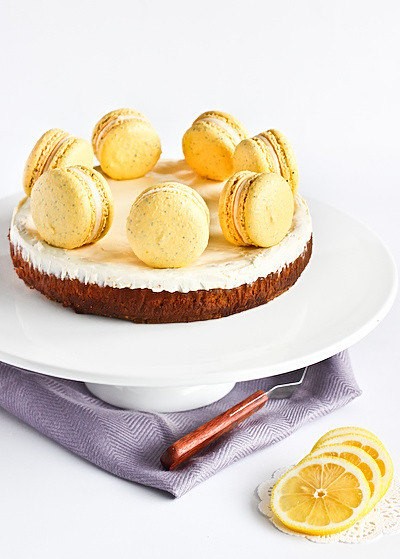
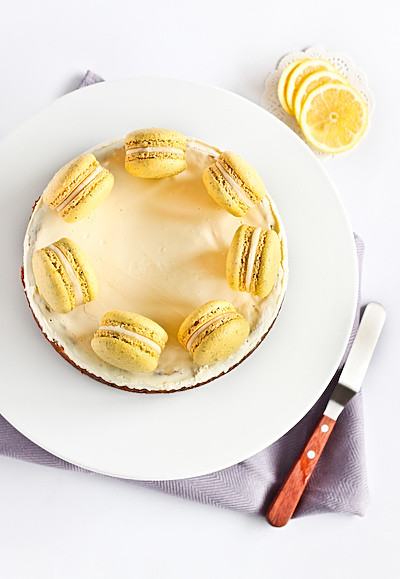
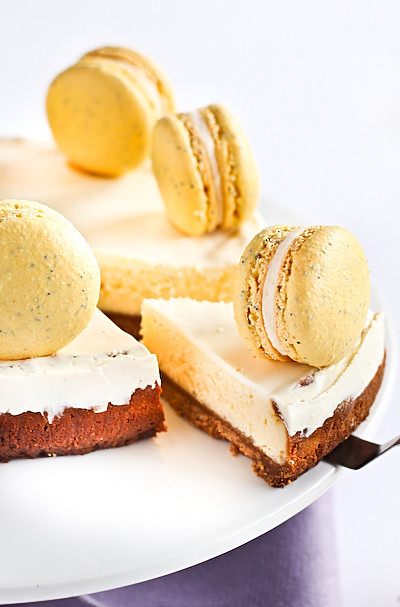

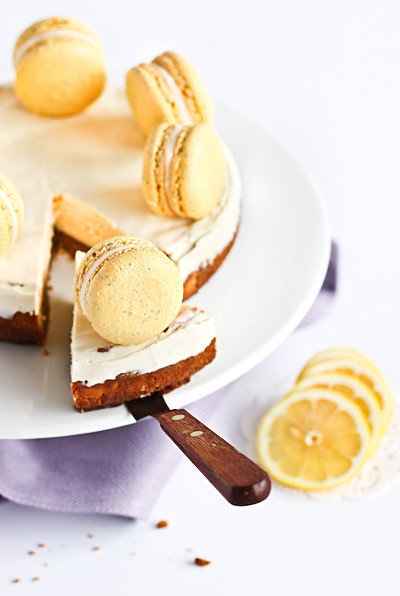
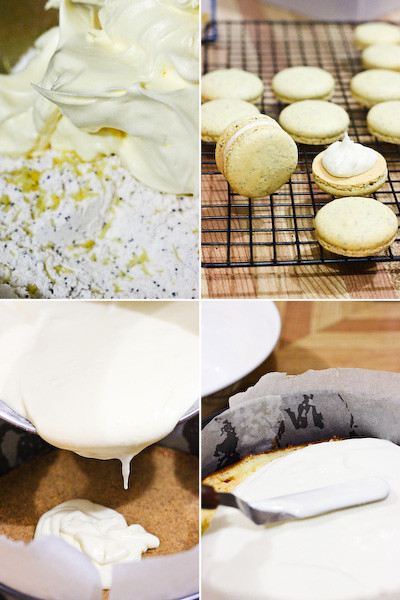
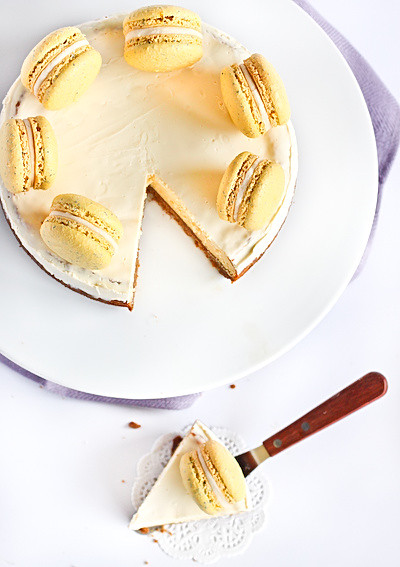





0 comments:
Post a Comment